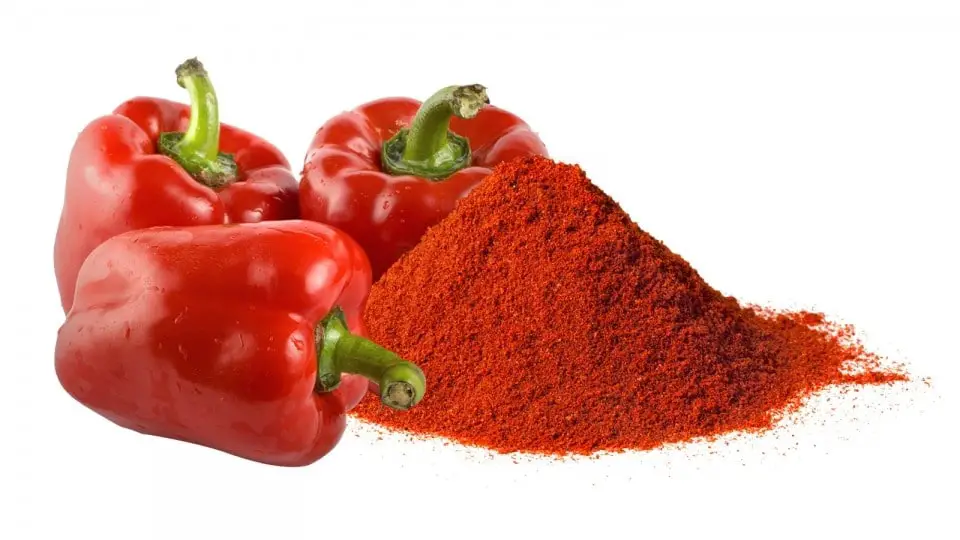Have you ever wondered about the origin of paprika — where the burst of color and flavor in your favorite foods comes from? Contrary to popular belief, paprika doesn’t come from an exotic plant. It’s derived from the very same peppers found in your local grocery store.
But paprika’s significance stretches beyond its culinary appeal. With its nutritional value and health-enhancing potential, paprika stands as a truly remarkable ingredient.
What Is Paprika?
Paprika is a ground spice crafted from a particular variety of red peppers known as Capsicum annuum. Interestingly, these red peppers are closely related to bell and chili peppers.
This makes paprika a culinary cousin, characterized by a blend of fiery and sweet nuances. So, when you sprinkle paprika onto your dish, you’re introducing a touch of both heat and sweetness that this spice is renowned for.
A Pinch of Paprika’s History
Paprika’s history begins in the late 15th century when Christopher Columbus introduced chili peppers from the Americas to Spanish monarchs. Originally ornamental, different forms of these peppers evolved into paprika and spread across Europe from Spain.
In the 16th to 17th centuries, the Turks introduced the spice to Hungary, where it became a staple and earned its name. The word “paprika” itself comes from the Serbian and Croatian word “papar,” meaning “pepper,” which was likely adapted into Hungarian during the Ottoman rule.
By the 19th century, paprika had become a staple in Hungarian kitchens and is synonymous with Hungarian cuisine today. [1,2]
Unpacking the Varieties of Paprika
Paprika is not just a one-note spice. Over time, it has evolved into several varieties, each carrying a unique flavor profile. Here are some notable types:
- Sweet Paprika: Also known as Hungarian sweet paprika, it’s mainly made from sweet, mild peppers and is the national spice of Hungary. This type of paprika provides a rich, sweet flavor without the heat, making it a popular choice for various dishes.
- Hot Paprika: Brings a spicy kick to dishes. Its ingredients include chili peppers, providing a more fiery flavor than its sweet counterpart.
- Smoked Paprika: Also known as Spanish pimentón, it has a deep, smoky flavor to dishes thanks to the smoke-drying process the peppers undergo. It’s used in dishes like paella for its robust flavor.
Exploring the Health Benefits of Paprika
Beyond its role in enhancing culinary delights, paprika boasts a considerable nutritional profile. Here are some of paprika’s scientifically supported health benefits to consider.
- Abundant in Antioxidants: Paprika holds a wealth of diverse antioxidants, notably carotenoids, adept at shielding your cells against free radical-induced harm. [3]
- Anti-Inflammatory Qualities: Capsaicin, which is found in paprika, is proven to exhibit anti-inflammatory attributes. [4]
- Enhanced Eye Health: A noteworthy source of vitamin A, paprika contributes significantly to the maintenance of optimal eye health. [5]
- Potential Digestive Aid: Emerging research suggests that paprika’s capsaicin content can potentially foster healthy digestion by stimulating stomach acid production and encouraging a balanced gut microbiome. [6]

Paprika in Cooking
Paprika, a widely used seasoning in various cuisines, adds a pop of red to pretty much any dish and perfectly complements lighter dishes with its hint of sweetness. Its popularity extends to Spain, Mexico, and the Balkan Peninsula, and it’s particularly integral to Hungarian cooking, essential for dishes like gulyás, pörkölt, paprikás, and tokány.
While paprika is grown in many places worldwide, the Spanish and Hungarian varieties are considered the best. Each of these has multiple types with distinct characteristics.
Here are some ways you can use paprika to add flavor and excitement to your dishes:
Paprika Spice Rub
Ingredients:
- 2 tablespoons paprika (Hungarian, Spanish, or regular)
- 1 tablespoon brown sugar
- 1 tablespoon salt
- 1 teaspoon black pepper
- 1 teaspoon garlic powder
- 1 teaspoon onion powder
- 1/2 teaspoon cayenne pepper (optional, for heat)
Instructions:
- In a small bowl, combine the paprika, brown sugar, salt, black pepper, garlic powder, and onion powder.
- Use a fork or a small whisk to mix all the ingredients together until well combined.
- Sample a tiny amount of the rub and adjust the seasoning to your liking. You can add more sugar for sweetness or cayenne for heat, for example.
- Generously sprinkle the spice rub onto your meat, fish, or vegetables. For meats, you can rub the mixture in for deeper flavor and let it sit for at least 30 minutes. If you’re marinating meat, let it sit for up to 24 hours in the refrigerator for even better flavor.
Paprika Salsa
Ingredients:
- 4 medium tomatoes, diced
- 1 small red onion, finely chopped
- 1-2 cloves garlic, minced
- 1 jalapeño, seeded and finely chopped (optional)
- Juice of 1 lime
- 2 tablespoons olive oil
- 2 teaspoons paprika
- 1 teaspoon salt, or to taste
- 1/2 teaspoon black pepper
- 1/4 cup fresh cilantro, chopped (optional)
Instructions:
- Dice the tomatoes, chop the red onion and jalapeño (optional), and mince the garlic. If you prefer cilantro, chop it finely as well. Combine them in a medium mixing bowl.
- Pour in the olive oil and lime juice, then add the paprika, salt, and black pepper. Mix well to combine all the ingredients.
- Give the salsa a taste and adjust the seasoning, if needed. If you find the salsa too acidic, you can add a little more olive oil to balance the flavors.
- If you’re using cilantro, fold it into the salsa to give it a fresh, herbal note.
- For best results, cover the bowl and let the salsa sit in the fridge for at least 30 minutes to allow the flavors to meld together.
My Personal RX for Wholesome Culinary Adventures
I just love opening up a jar of paprika and letting its vibrant aroma fill the kitchen. Spices like paprika are essential additions to any kitchen, bringing a burst of flavor and excitement to home cooking. But it’s not just about taste – these spices also offer health benefits that contribute to your overall well-being.
Here are my personalized recommendations for maximizing the health advantages offered by paprika and other wholesome ingredients stocked in your kitchen.
- Diversify Your Plate: While spices like paprika certainly bring numerous benefits, it remains crucial to diversify your meals by including a range of vibrant fruits and vegetables. The array of nutrients in different produce items supports your body’s needs.
- Practice Portion Control: Enjoy your favorite condiments and treats in moderation. Balancing indulgences with nutritious choices keeps your diet on track.
- Stay Hydrated: Drinking an adequate amount of water daily is crucial for digestion, skin health, and maintaining energy levels.
- Explore More Healthy Recipes: Looking to spice up your meals? Check out my Superfoods Cookbook for innovative dishes that showcase the benefits of paprika and other nourishing ingredients.
- Power Your Body: Discover the potential of turmeric by trying Complete Turmeric Matrix. These supplements capture the natural health advantages of turmeric for your well-being.
Remember to consider your personal preferences and any dietary restrictions when incorporating paprika into your meals. Enjoy the journey of exploring this versatile spice and its various applications in your culinary creations!

Sources:
- Billock, J. (2019, May 13). The Smoked Paprika Museum in Spain honors a family tradition. Smithsonian Magazine. https://www.smithsonianmag.com/travel/smoked-paprika-museum-spain-honors-family-tradition-180972052/
- McCormick Science Institute. (n.d.). Paprika | McCormick Science Institute. https://www.mccormickscienceinstitute.com/resources/culinary-spices/herbs-spices/paprika
- Ponder, A., Kulik, K., & Hallmann, E. (2021). Occurrence and Determination of Carotenoids and Polyphenols in Different Paprika Powders from Organic and Conventional Production. Molecules, 26(10), 2980. https://doi.org/10.3390/molecules26102980
- Shang, K., Amna, T., Amina, M., Al-Musayeib, N. M., Al-Deyab, S. S., & Hwang, I. (2017). Influence of capsaicin on inflammatory cytokines induced by lipopolysaccharide in myoblast cells under in vitro environment. Pharmacognosy Magazine, 13(49), 26. https://doi.org/10.4103/0973-1296.203984
- Abdel-Aal, E. M., Akhtar, H., Zaheer, K., & Ali, R. (2013). Dietary sources of lutein and zeaxanthin carotenoids and their role in eye health. Nutrients, 5(4), 1169–1185. https://doi.org/10.3390/nu5041169
- Xiang, Y., Xu, X., Zhang, T., Wu, X., Fan, D., Hu, Y., Ding, J., Yang, X., Lou, J., Du, Q., Xu, J., & Xie, R. (2022). Beneficial effects of dietary capsaicin in gastrointestinal health and disease. Experimental Cell Research, 417(2), 113227. https://doi.org/10.1016/j.yexcr.2022.113227




















